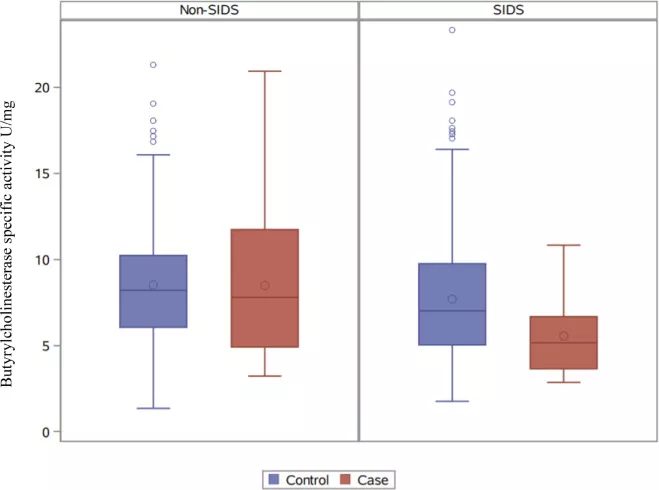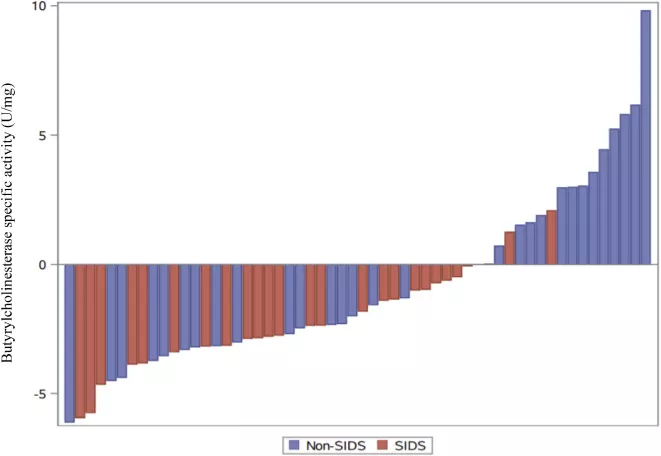On May 6, 2022, it was published in [ebomedicine], a comprehensive sub Journal of the lancet( https://www.thelancet.com/journals/ebiom/article/PIIS2352-3964 (22) in a study in the Journal 00222-5 / fulltext), researchers found that the activity of a specific enzyme, butyrylcholinesterase (BChE), was significantly lower in infants who later died of SIDS than in living controls and other infant deaths.

The study analyzed BChE activity in 722 dry blood points (DBS) taken at birth as part of the neonatal screening program, using only samples approved by parents for non identification studies. BChE was measured in infants with sudden infant death syndrome and those who died from other causes, and each infant was compared with 10 surviving infants of the same date of birth and sex.
Sudden infant death syndrome (SIDS), commonly known as "cradle death", refers to the sudden unexplained death of children under the age of one year. SIDS usually occurs during sleep. Deaths often occur between midnight and 9 a.m., and there is usually no evidence of noise or struggle. In western countries, sudden infant death is still the main cause of infant death, accounting for half of all neonatal deaths.

The researchers found that infants with lower BChE levels had a much higher risk of dying from SIDS. BChE plays an important role in the wake-up pathway of the brain. Researchers believe that its lack is likely to indicate insufficient wake-up, which reduces the ability of infants to wake up or respond to the external environment, making them vulnerable to SIDS.
Dr. Carmel Harrington, the study leader and CHW honorary researcher, said that these findings have changed the rules of the game, providing not only hope for the future, but also answers for the past.
"The inability to wake up after an apparently healthy baby falls asleep is a nightmare for every parent. Until now, we have no way to know which baby will give in. But now the situation is different. We have found the first marker of vulnerability before death," Dr. Harrington said.
"Babies have a very powerful mechanism to let us know when they are unhappy. Usually, if a baby encounters a life-threatening situation, such as difficulty breathing due to lying down in sleep, they will be awakened and cry. What this study shows is that some babies do not have this strong arousal response."
"This has long been thought to be the case, but so far, we don't know what caused the lack of arousal. Now we know that BChE is involved, and we can start to change the outcome of these infants and make SIDS a thing of the past."

29 years ago, Dr. Harrington lost her child due to SIDS. She has been working on the disease and supported most of her research through her crowdfunding activity "Damien's legacy".
"This finding provides the possibility of intervention and ultimately the answer for parents who have unfortunately lost their children. These families can now know that it is not their fault," Dr. Harrington said.
In recent years, the overall incidence rate of SIDS has been reduced by more than half because public health campaigns have addressed known major risk factors such as prone lying, maternal smoking and overheating. However, the incidence rate of SIDS in western countries is still very high, accounting for nearly 50% of all neonatal deaths in western countries.
"There is a view that SIDS is no longer a problem, or that it can be solved if all babies have the right sleep conditions, but in Australia, two children still die of SIDS every week." Professor Karen waters, head of CHW's SIDS and sleep apnea research group, said: "this finding provides a clear direction for our research so that we can do something to prevent it in the future."
At present, "triple risk model" is used to explain the occurrence of SIDS, assuming that three factors need to occur at the same time; Vulnerable infants, critical developmental stages and exogenous stressors, but until now, there has been no way to identify these vulnerable infants.
The identification of BChE biochemical markers provides a clear future direction for researchers to focus on introducing such markers into neonatal screening and developing specific interventions to address the lack of enzymes.
The researchers expect that the next research phase will take about five years to complete.
"This discovery changes the story around SIDS and is the beginning of a very exciting journey in the future. We will be able to work with babies while they are alive and ensure that they continue to live," Dr. Harrington said.